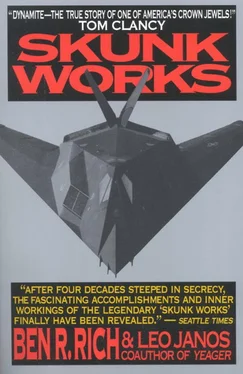Still another area of potential cost reduction is security. A classified program increases a manufacturer’s costs up to 25 percent. I believe in maintaining tight perimeter security to guard the plant site and keep sensitive materials under lock and key. If we don’t allow our people to take out sensitive papers, then we don’t have to worry about it. We need to safeguard technologies and weapons systems, but we don’t need to hide behind secrecy as a means to cover up mistakes or to block oversight by outside agencies. In the past, the government has slapped on way too many security restrictions in my view. Once a program is classified secret it takes an act of God to declassify it. We should limit its use and be tough about periodic declassification reviews. What was secret in 1964 often is probably not even worth knowing about in 1994. I would strongly advocate reviews every two years of existing so-called black programs either to declassify them or eliminate them entirely. We could save millions in the process.
Just one very practical problem about classification that any reader would immediately understand: how do you transport from Burbank to Washington highly sensitive blueprints or performance studies stamped top secret? Do you call in Federal Express? Do you send them by registered mail? No. You use a special courier, who carries the material in a locked case handcuffed to his wrist. If the material is extremely sensitive, the means of transportation is usually government-chartered flight or use of multiple couriers. So, secrecy classifications are not inconsequential but a burden to all and horrendously expensive and time-consuming. If necessarily in the national interest, these expenses and inconveniences are worthwhile. But we ought to make damned sure that the secrecy stamp is absolutely appropriate before sealing up an operation inside the security cocoon.
Sunset laws on security are an important first step toward real dollar saving. But government has a long list of needed reforms in the area of imposing sunset provisions on dozens of unnecessary regulations. Companies with solid track records should be rewarded with less supervision and outside interference, while companies that fail to meet performance requirements should be penalized severely.
Under existing laws if a company actually brings in a project at considerably less cost than called for in the original contract, it faces formidable fines and penalties for overbidding the project. Not much motivation to save time and money, is there?
All of us in the defense industry would benefit from multiyear funding. The laws require that all procurement allocations be on a strict annual basis, so that when the Air Force reopened the production line on the U-2 back in the early 1970s, for example, and I knew that I would be building about thirty-five U-2s—five a year for the next seven years—I still was prohibited from tooling up for five-years’ worth of parts or materials. Not only might the blue-suiters cancel the program, forcing me to eat all those parts for breakfast, but it is against the law for a manufacturer to spend money that has not actually been appropriated. I could be severely fined or penalized by losing the contract entirely if I tried to stock up for several years’ worth of materials and parts and tools. But by doing so, I could probably reduce my production costs if I were allowed to purchase in volume tooling and materials for, say, three years at a time, rather than doing so annually and incrementally.
Frankly, I think the government prefers this annual funding system because it can then promise a company the moon and the stars in order to get it to put up significant development capital, then later sharply reduce the procurement, as in the case of the F-22.
One of the bitter lessons of failure that Rockwell learned while building the ill-fated B-1 bomber was that in retrospect they surrendered too much authority and responsibility to the customer. The Air Force allowed Rockwell to build the airframe of the bomber, but the critical onboard avionics, both offensive and defensive, were in the hands of blue-suiters and were uncoordinated and out of sync with the airframe builders. Ultimately, it would cost millions to undo their mistakes. The lesson is that there is no substitute for astute managerial skills on any project. In the absence of effective managers, complex projects unravel. And, by the way, there is an even greater shortage of skilled managers than of effective leaders in both government and industry nowadays. Leaders are natural born; managers must be trained. When Noah designed an ark and gathered his family and a pair of male and female animals of all species to avoid the Great Flood, he demonstrated his leadership. But when he turned to his wife and said, “Make certain that the elephants don’t see what the rabbits are doing,” he was being a farsighted, practical manager.
I will leave it to historians to debate the effects of our own astronomical defense spending, particularly during the Reagan administration, on the demise of the Soviet Union. Did we really spend them into self-destruction, or did their own corruption and an almost nonexistent functioning economy do the job irrespective of military outlays? Or is the truth somewhere in between? There is no doubt that we ran up enormous debts ourselves that have almost wrecked our own free enterprise system by chasing after enormously costly technologies that were simply beyond our creative grasp. The Reagan administration’s Strategic Defense Initiative is a case in point. This was the so-called Star Wars concept of employing an impenetrable defensive shield capable of destroying all incoming enemy missiles launched against us. In an actual all-out nuclear attack, hundreds of missiles would be raining down on us, including many decoys. SDI would instantly acquire them all, distinguish between real and decoys, and save our bacon by knocking out all those nuclear warheads at heights and ranges sufficiently far removed from our own real estate. Some of us thought that SDI stood for Snare and Deception with Imagination, even though it was supposedly the brainchild of Dr. Edward Teller, the father of the hydrogen bomb, who sold the concept to President Reagan. The trouble was that the technologies to make this system function as advertised were not even on the horizon and would ultimately cost trillions of dollars to develop over many, many years. The administration allocated about $5 billion annually in R&D, which did result in some advances in laser and missile research.
Its apologists justify these costs with the claim that the Russians really believed in the seriousness of the administration’s intent and were panicked into disastrous spending to try to overcome SDL If so, we spent a hell of a lot of money in deception and very little in behalf of worthwhile technology. And that will always be the result unless the new technology we are attempting to create is really within practical reach of our current abilities and achievable with reasonable expenditures.
Lockheed’s Skunk Works has been a dazzling example of American aerospace at its best, setting the standards for the entire U.S. industry in developing aircraft decades ahead of any others in performance and capability. Fifty years is a long time for a very small development company to stay in business, much less to maintain its unusual competence and morale. But if we are to survive a future every bit as uncertain and turbulent as the past, we will need many more skilled risk-takers like the ones first brought together on the initial Skunk Works project during World War II, to build the first U.S. jet fighter.
We became the most successful advanced projects company in the world by hiring talented people, paying them top dollar, and motivating them into believing that they could produce a Mach 3 airplane like the Blackbird a generation or two ahead of anybody else. Our design engineers had the keen experience to conceive the whole airplane in their mind’s-eye, doing the trade-offs in their heads between aerodynamic needs and weapons requirements. We created a practical and open work environment for engineers and shop workers, forcing the guys behind the drawing boards onto the shop floor to see how their ideas were being translated into actual parts and to make any necessary changes on the spot. We made every shop worker who designed or handled a part responsible for quality control. Any worker—not just a supervisor or a manager—could send back a part that didn’t meet his or her standards. That way we reduced rework and scrap waste.
Читать дальше












